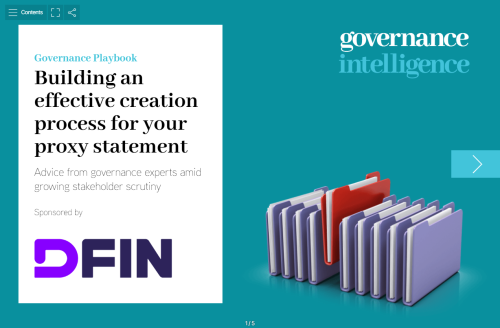 With the 2024 shareholder meeting season in the books, companies across the US already need to be conscious about what comes next: shareholder engagement season. There are plenty of tactics here, and expertly executing shareholder engagement requires the assistance of an adviser with deep knowledge of the shareholder meeting and institutional investor landscape.
With the 2024 shareholder meeting season in the books, companies across the US already need to be conscious about what comes next: shareholder engagement season. There are plenty of tactics here, and expertly executing shareholder engagement requires the assistance of an adviser with deep knowledge of the shareholder meeting and institutional investor landscape.
Mandated by the SEC, for instance, N-PX filings detail the proxy voting records of registered funds, giving issuers insight into how investors voted at their shareholder meeting. But to truly understand investors’ motivations, companies should directly engage with them during the off-season.
Investors signal their expectations for public companies through their proxy voting policies, which are publicly available and updated once a year. These proxy voting guidelines offer a sense of potential issues for shareholder meetings.
Shifting through the paperwork can certainly secure valuable insights – a recent study by Deloitte and Tufts University, for example, finds that 83 percent of professional investors across the US now boast specific ESG policies.
The sheer breadth of shareholder pressure points requires a more holistic approach, ultimately one that involves year-long engagement because there are countless issues for which investors apply case-by-case analyses, and speaking directly with the investor can shed light on how it may vote on a particularly nuanced matter.
A range of challenges
The scale of the challenges facing US corporate leaders is clear from the numbers and it is imperative that issuers understand key stakeholders’ evolving expectations. So how should executives react? SEC forms and policy documents are a good start. But to truly get to grips with what shareholders want, companies can’t simply wait for contact – rather, they should proactively engage investors to understand their concerns.
In-person meetings (most over Zoom or Teams) are obviously important here: the statistics make clear that letter writing won’t get leaders far. Just as crucial is thinking carefully about which stakeholders to approach. While calls with investor portfolio managers are important from a financial perspective, stewardship or responsible investor teams are the groups that ultimately make proxy voting decisions.
In a broader sense, companies should rely on their last shareholder meeting results to decide which issues to focus shareholder engagement efforts on over the coming year. As a rule of thumb, any resolution receiving below 80 percent support from shareholders requires a robust corporate response. Shareholder resolutions creeping over the 20 percent support threshold are even more urgent.
Transparency and speed
Once companies have pinpointed the main shareholder worries – and which investor teams to engage – what should they do next? In the first place, we’d recommend speaking to every stakeholder willing to have a conversation, including those rejecting the company line.
If, moreover, it becomes clear that a majority of respondents are worried about a particular policy, executives should move fast. In reality, of course, implementing changes might take years. Nevertheless, corporations should signpost their intentions in advance and clearly explain timelines.
Whatever the challenge, leaders would be wise to link change with wider business goals. Beyond fulfilling their primary professional function, this is what investors increasingly expect: 63 percent across the US prefer that ESG goals connect with shareholder value through quantitative data. The same is true of cyber-security: with each major incident sparking a 9 percent drop in value, there’s clearly space for companies to balance ethics and the bottom line.
Not that a universal approach necessarily works, either. Once again, dialogue is the watchword here, helping executives determine exactly what shareholders are looking for. When it comes to compensation, for instance, every investor has its own preferred style – and major US corporations, from Apple to Visa, may feel shareholder principles do not allow for industry-specific considerations.
One important way to break the deadlock is transparency, ensuring investors can judge companies on their progress. Around environmental concerns, for instance, companies could publish greenhouse gas targets. For cyber-security, they could pledge to appoint IT experts to the board – especially urgent with those SEC changes – and this is an approach giants like Amazon are increasingly extending to AI.
Openness is doubly important for corporate compensation. Publishing financial or other goal data for short-term incentive schemes is one good example. And though firms may worry that publishing puts them at a competitive disadvantage, transparency means they can prove their metrics are fair, especially when payouts are higher than expected.
It’s a similar story elsewhere: publishing shareholder feedback and issuing follow-up statements are both ways of keeping investors engaged long after the shareholder meeting season ends. Another tactic is leveraging expert advice, helping busy executives keep abreast of stumbling blocks all year round.
For more information, please click here.
Michael Vogele is managing director of the global advisory group at Alliance Advisors









